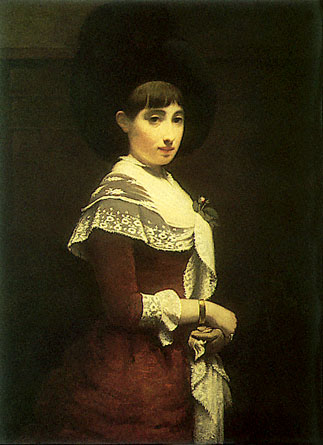| Some Terms Brit Bat: covenant for the daughter Berit ha Bat: covenant for the new daughter Shalom Nekeva: welcome to the female Shalom Bat: welcome to the new daughter Simchat Ha-bat: joy of the new daughter Brit Ha-hayim: covenant of life (http://www.ritualr.com/britbat.shtml) |
 |
| Young Jewish Girl image from Lycos Image Gallery and Pictures Now |
The Brit ha Bat (naming ceremony of a baby girl) and Brit Milah (circumcision and naming of a baby boy) ceremonies establish and confirm the Hebrew name of a newborn baby. Jewish tradition holds that a person's name describes their true essence, provides them with identity, and connects them to their ancestors. The act of naming is creative and empowers the child. It can be related to God's empowerment of Adam with the first human task, to name animals. A child's shem kodesh (sacred Hebrew name) represents great potential since it describes and defines the child's personality and identity. In Exodus 3:13-22 Moses asks what God's name is. God's response makes clear that his name describes God's essence and deeds. (Judaism 101) More evidence of the importance and changing power of naming comes in God's renaming of Abraham and Sarah. When Abraham fulfilled the commandment of milah, God gave him and Sarah new names and thus new identities as parents of a new nation. For a mohel's explanatory page on naming click here.
Shalom Bat, "Welcoming the New Daughter"
Usually, the naming of a baby girl is done at the first Torah reading after her birth. This is different from Brit Milah ceremonies which are by regulation always done when the baby boy is 8 days old. Some common elements of the Brit ha Bat celebration include readings from Psalm 128 and Song of Songs, a divrei torah (lessons meant to give meaning to the weekly torah reading), and Kiddush (a prayer over the wine). The baby is sometimes symbolically dipped in a small mikvah. The baby comes to the ceremony in a covenant bag that will become a keepsake used later in Bat and Bar Mitzvahs and weddings. Being inside the bag binds the child to all other Jews in the world who have been in the same place, creating one unified community. (Ritual Reality)
|
|
|
covenant bag image from Ritual Reality |
Judith Plaskow sees female birth ceremonies as places for feminist ritual creativity. Because Brit Bat is not based in historical ritual, rather, in the desire to celebrate daughters and has no traditional, set form, there is ample room for creativity and exploration. Some women borrow traditional midrash and blessings for their daughters' namings, some use symbols that apply to women, some combine old and modern notions. Plaskow explains that two other practices commonly included in naming ceremonies are the washing of feet, an ancient symbol of welcoming, and immersion in a small mikveh, which represents the baby girl's sexuality. Plaskow's personal ritual for the birth of a daughter places the baby girl in the context of the history of Jewish women. At the ceremony the girl is told stories of biblical women who make up the covenant she is entering into. (Plaskow, 58)
Here is an example of the kind of celebration prayer that I believe Plaskow would appreciate:
O my dove in the rocky clefts,
In the shelter of terrace high
Let me see your face
Let me hear your voice
For your voice is sweet
And your face is beautiful.
One alone is my dove, my perfect one,
The darling of her mother,
The delight of her who bore her.
Daughters saw her-they acclaim her,
Queens and consorts-they sang her praises.
May the One who blessed our mothers, Sarah, Rebecca, Rachel and
Leah, Miriam the prophetess, Abigail and Esther the queen, bless also
this darling baby. May the One bless her to grow up in comfort, health, and happiness.
May the One bless her with the strength and inner beauty of her
Grandmothers and Great Grandmothers. May this be the will of God, and let us say Amen.
(Sara's Site)
Conclusion
Unlike Brit Milah (circumcision ritual for boys), Brit ha Bat is not a covenant required in the Torah. There is no set ceremony or rules to the way the ritual goes. Some people use the prayers and ritual practices that I have listed, but others do not. Therefore Brit ha Bat ceremonies are open to creativity, experimentation, and innovation. Because of the power of identity and potential that a new name brings, the creation of non-structured naming ceremonies for women has given women control and freedom to create identity and celebrate their own relationship with God.
Bibliography
Plaskow, Judith. Standing Again at Sinai. San Francisco: Harper & Row, 1990.
Cantor Mark Kushner's Web Page
Judaism 101, an Online Encyclopedia: Birth
Judaism 101, an Online Encyclopedia:About Names
Sara's site: includes information on her Brit ha Bat ceremony